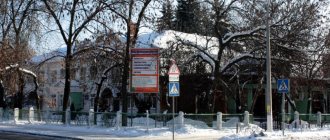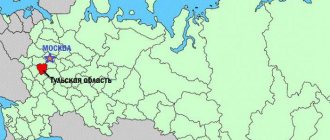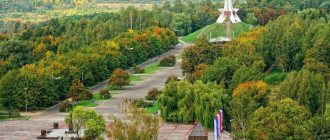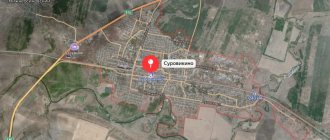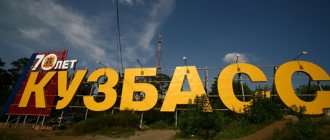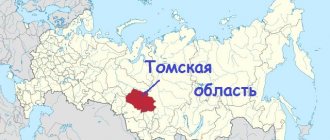The Stavropol Territory belongs to the center of the Caucasus, its borders pass through the Krasnodar Territory, Rostov Region, Kalmykia, Dagestan, North Ossetia, as well as through the Chechen and Karachay-Cherkess Republics.
This territory is famous for its natural attractions: beautiful valleys, clean rivers, mountain ranges, and healing springs. Everyone knows the healing properties of Caucasian mineral waters and mud from the sources of Lake Tambukan. The undoubted pearl of the region is the city of Kislovodsk and Essentuki; it is from the springs located in this territory that Narzan and Essentuki water, known for its healing effect, is produced.
At the foot of the Caucasus Mountains are the centers of the ski resort, which attracts tourists from all over the world. And the snow cap of Elbrus has turned into the calling card of avid climbers.
In this area you can not only relax, but also conduct scientific research, since the region is rich in plant flora and animal fauna. This area is convenient for relaxing, hunting, and fishing.
Edge Features
The climatic conditions of the area are favorable, spring begins in March and lasts until the end of May, the average temperature during this period is +15 degrees and frequent rains are observed. Summers are warm and dry, there is little precipitation, and temperatures can reach +40 degrees, but given that the region has a large number of forests, plantings, lakes and rivers, this is not greatly felt.
Autumn begins in September-October and is characterized by heavy rains, but in November the first snow falls. Winter is not stable, temperatures can fluctuate from +15 to -25 degrees.
The nature of Stavropol is rich in mountain peaks (Strizhament, Nedremanna, Beshtau, Mashuka), steppe and semi-deserts (in the northeast), as well as meadows, forest-steppes and deciduous forests.
In the semi-deserts grow black and white wormwood, ephedra, wheatgrass, prickly thistles, in spring the area comes alive everywhere, tulips, soft lilac crocuses and hyacinths are visible.
The eastern part of the region is characterized by the presence of wormwood-grass and wormwood-fescue dry steppes.
The west and north-west gives way to semi-desert for fertile lands with plowed and untouched steppes and plantings of rural gardens. Common herbs here include: feather grass, fescue, strawberry, meadowsweet, forget-me-not, yarrow, purple-red peony, and many shrubs.
Forests in the Stavropol Territory are located on the Vorovskolessky and Darinsky heights, in the mountains of Pyatigorye, on the Dzhinalsky ridge, in valleys and gullies in the southwest, in the areas of the Kuban, Kuma, and Kura rivers. These are mainly broad-leaved and oak-hornbeam, fir, maple forests, as well as beech, ash and linden.
The largest rivers are Kuban, Terek, Kuma, Kalaus and Egorlyk; in addition to them, there are about 40 small and large lakes.
Sights of the Stavropol Territory
The vast majority of attractions in Stavropol are natural beauties. One can argue for a very long time which of these relics is more valuable, but it is better to see each of the sights of the region with your own eyes.
For example, Honey Falls near the Alikonovka River. Of course, it’s not honey that flows from the slopes, but water, but the plants growing here exude incredibly sweet aromas. The waterfalls got their name from the fact that there were once many beehives in the river valley, so that honey flowed down along with the water. Thanks to the name, there is even a tradition among newlyweds to spend their honeymoon in one of the local boarding houses.
The largest man-made park in Europe is located in Kislovodsk. Many hectares of planted trees are divided into three parks, running from the center of Kislovodsk to the mountain peaks of Maloye and Bolshoye Sedlo. Particularly noteworthy are the rose gardens created in the park. From the height of the cable car, the “field” of roses looks unforgettable.
Also not far from the city there is literally the calling card of Stavropol - the ring mountain. Mother Nature made an absolutely smooth, round, even hole in the spur of the Borgustan ridge.
And, of course, many mud and hydropathic centers. For example, the famous Drinking Gallery in Essentuki, where five thousand people can simultaneously taste the healing water.
In addition, the Stavropol region has several dozen ancient settlements. In Stavropol alone, archaeological scientists have discovered eight ancient settlements. These places keep traces of long-gone times: Buddenovsk was once the center of the Golden Horde, and near Kislovodsk, sites of ancient people were discovered that are more than three thousand years old. One of these archaeological monuments, the Madzhary settlement, is located on the territory of Buddenovsk. The museum on the site of the Settlement not only stores Madjar relics, but also recreates the appearance of the ancient city on a model.
There are also many unusual attractions here. For example, all visitors to Pyatigorsk are invited to find Ostap Bender and follow his path from the film “12 Chairs,” which was filmed here near Mount Mashuk.
Animals
The fauna of the region includes more than 400 different species, these include predators, herbivores, artiodactyls, and insectivores.
Boar
Wild boars are formidable inhabitants of the forest; they are large in size and have large tusks; they are hunted.
Brown bear
Brown bears are listed in the Red Book. This is a very strong animal with a powerful body and thick hair, its lifespan is 35 years, and its weight is about 100 kg in the spring, before winter the weight increases by 20%. They prefer to live in dense forests and swampy areas.
Jerboa
The jerboa is found in forest-steppe and semi-desert, very fast animals, their speed can reach 5 km per hour, they move on their hind legs.
Interesting facts Stavropol region. Special signs. What is the Stavropol Territory famous for?
The Stavropol region, which will celebrate its 212th birthday on May 17, has become famous on various fronts: as the homeland of a dozen famous people throughout Russia, as a territorial exclusive, as a habitat for elephants, as a convenient “5 hours to the sea - 5 hours to the mountains” for recreation, the region is a sanatorium-resort complex and an aeronautics center. AiF-SK has prepared the entire range of associations that arise in Russians when they hear the phrase “Stavropol Territory”.
Small Motherland of Gorbachev
Every third Russian, when mentioning the Stavropol Territory, remembers the first and last president of the USSR, Mikhail Gorbachev. His relatives still live in the village of Privolnoye, and in the local House of Culture guests are greeted by a portrait of the President of the Union. And if some sing praises to the last General Secretary of the CPSU Central Committee, then others, at every opportunity, accuse their fellow countryman of the collapse of the Union.
A dozen more famous heroes were also born in the Stavropol region, including General Secretary of the CPSU Central Committee Yuri Andropov, People's Artist of the USSR Ivan Solovyov, Nobel Prize laureate in literature Alexander Solzhenitsyn, founder of the group “Tender May” Andrei Razin and others. You can treat them differently, but it cannot be denied: all of them, one way or another, glorified the region - some with exploits, some with scandals, some with flowers.
Natural resources
Stavropol region is famous for its mineral waters. The first hot spring to be discovered was in Pyatigorsk, back in 1801. At the same time, a fact was stated: resources can be used for medicinal purposes. By decree of Alexander the First, the regulations on the Caucasian Mineral Waters were approved, and the historical Rescript “On recognition of the national significance of the Caucasian Mineral Waters and the need for their construction” was signed. Thus began the official existence of the resort area. Unique reserves of local mineral waters are now widely known throughout the world - these are “Narzan” and “Essentuki”. In addition, the total amount of hydromineral resources is sufficient to cover the needs of the KMV resort and sanatorium complex and about 50 bottling plants located in this region.
Place of the great poet's duel
For many, the Stavropol Territory is the region where Mikhail Yuryevich Lermontov spent the last days of his life. Near Pyatigorsk, at the foot of Mount Mashuk, in 1841 a duel between the great poet and Nikolai Martynov took place. The house where Lermontov lived has survived to this day. And the poet’s personal belongings are still kept in the ancient Pyatigorsk estates.
Animals of steppes and semi-deserts
In the steppe and semi-desert there are:
Saiga antelope
The saiga antelope (saiga) is on the verge of extinction; this artiodactyl animal prefers to settle in the steppes and semi-deserts. The mammal is not large in size with a trunk-shaped nose and rounded ears. Horns are found only on males, who are much larger than the female.
Sand corsac fox
The sand corsac fox belongs to the Canidae family; it is smaller than an ordinary fox and has a short sharp muzzle, large ears and long limbs, a height of 30 cm, and a weight of up to 6 kg. Prefers steppe and semi-desert.
The sand badger lives in dry areas not far from water bodies and is nocturnal. Omnivorous.
long eared hedgehog
The long-eared hedgehog, a representative of this species, is small in number; they look like an ordinary hedgehog, only with very large ears, and are nocturnal.
Midday Gerbil
The crested and midday gerbil belongs to the species of Rodents and has golden-red (midday) and brownish-gray (combed) colors.
Back in the days of the Soviet Union, the following animal species were acclimatized:
Nutria
Nutria is a rodent, reaching a length of up to 60 cm and a weight of up to 12 kg, with the largest weight in males. It has thick fur and a hairless tail, which acts as a rudder when swimming. The animal settles near bodies of water, does not like the cold, but is able to withstand frosts of -35 degrees.
Raccoon dog
The raccoon dog is an omnivorous predator of the Canidae family. The animal looks like a cross between a raccoon (color) and a fox (structure), lives in burrows.
Altai squirrel
The Altai squirrel is much larger than an ordinary squirrel and has a black-brown, bright black color with a blue tint. In winter, the fur lightens and acquires a silver-gray tone. Lives in coniferous deciduous forests.
Altai marmot
The Altai marmot has long wool of a sandy-yellow color with an admixture of black or black-brown, and can reach 9 kg.
Dappled deer
Sika deer, in summer it has a red-red color with white spots, in winter the color fades. Lives in the wild for no more than 14 years. The animal lives in deciduous forests and prefers oak plantations.
Roe
The roe deer belongs to the genus Deer; it is dark red in color in summer and gray-brown in winter. Refers to permitted hunting objects.
In the Stavropol Territory there are extensive hunting grounds where you can hunt wild boars, muskrats, and pheasants. It is possible to purchase a hunting license for waterfowl, wolf, fox, marten, hare and gopher.
History of Stavropol. Stavropol (city history)
Stavropol
Stavropol is one of the largest cities in the North Caucasus region. Before its current name, Stavropol changed its name twice: until 1935 it was called Stavropol-Caucasian, from 1935 to 1943 it was called Voroshilovsk.
Stavropol is a regional administrative center with a multinational population of about half a million people.
In the annual competition of cities “The most comfortable city in Russia”, in 2013 and 2015 Stavropol was recognized as the winner.
The city has an advantageous geographical location with a developed transport network, two international airports, and the tourism sector and health resort treatment continue to expand.
Description of Stavropol
Stavropol is located south of Moscow at a distance of 1,450 kilometers. The southern city is called the “Gateway of the Caucasus”. More recently, scientists have noticed one unique feature - the geographical location of Stavropol. The city is located at the same distance from the North Pole and the equator, more precisely, in the very heart of the northern hemisphere.
Stavropol spreads over an area of over 270 square kilometers. The administrative center consists of three districts: Leninsky, Oktyabrsky and Industrial.
The city stands at the intersection of the Caspian and Caucasus federal highways.
The industrial potential of the city consists of industrial enterprises:
- machine-building, produces trailers for heavy-duty vehicles;
- JSC "Optron-Stavropol", manufacturer of semiconductor devices;
- radio, produces radio-electronic equipment for aircraft;
- Stavkhim LLC, household chemicals plant;
- several oil and gas industry enterprises.
Stavropol is a young city, the average age of the population is 35-45 years old, there are many secondary educational institutions, 20 universities, 11 colleges, several institutions of further education.
The administrative center is surrounded by greenery; in addition to the administration, the public organization “Ecological Patrol of Stavropol” is engaged in urban improvement. Residents voluntarily plant trees and bushes and take care of them themselves. The streets of the city are always clean, there are many parks, gardens, playgrounds, and green areas.
City `s history
The founders of the city of Stavropol are considered to be two outstanding figures of Russia: government functionary G.A. Potemkin and commander A.V. Suvorov.
Stavropol was built as a stronghold, an outpost in the North Caucasus.
To strengthen the southern borders of Russia after the Russian-Turkish War, during the period from 1776 to 1780, the Azov-Mozdok fortified line with 10 fortresses was built. Stavropol was considered the seventh fort with a fortress on the top of Yegorlyk on Tashla. Between the fortresses, at a distance of 30-40 kilometers, fortified Cossack outposts were established. The great commander A.V. took part in strengthening the borders and planning the fortresses. Suvorov.
The city appeared thanks to a fortress built on a hill in 1778 and called the Stavropol-Caucasian Fortress. The 1st Khopyor Regiment of the Kuban Cossack Army was based in the bastion. The citadel housed Cossack officers, there were barracks, a gunpowder warehouse and outbuildings.
In 1824, by Decree of Emperor Alexander I, government institutions with local authorities were transferred to the fortress from Georgievsk.
Russian Emperor Nicholas I personally visited Stavropol in 1837.
In 1847, the Caucasus region, consisting of 6 counties, was renamed the Stavropol province.
From 1897 to 1916, the Tuapse-Elista railway line was built through Stavropol.
New time
In 1918, the entire territory of the Stavropol province, with the advent of Soviet power, became part of Soviet Russia, and the city of Stavropol was declared the capital. In the same year, in December, Stavropol became the administrative capital of the North Caucasus Republic.
During the civil war, from the autumn of 1918 to February 1920, the city periodically came under the control of the Red troops or the White Volunteer Army. At the end of February 1920, Stavropol was occupied by units of the Red Army.
During the Great Patriotic War, the city was occupied from August 1942 to January 21, 1943. The plans of the Hitlerite leadership included the creation of the Caucasus Reich Commissariat on Stavropol soil, a national education with the establishment of a “new order”. This remains a bloody page in the history of Varoshilovsk. During the occupation, the city not only lost its natural and industrial resources, more than 40 thousand people were forcibly taken to work in Germany.
After the war, the restoration of the city began. The 60-80s of the last century were at the peak of the development of industry and housing construction.
Now the city is thriving, there are many architectural monuments, stadiums and football fields, indoor ice arenas, three theaters, 10 cinemas, the famous Cossack song and dance ensemble “Free Steppe”.
Stavropol was visited by Russian classics: Pushkin, Lermontov, Tolstoy, Belinsky.
Rare animals
Caucasian jungle cat
The Caucasian jungle cat is a medium-sized animal with long paws and a short tail. Only a few individuals remain alive.
Caucasian forest cat
The Caucasian forest cat belongs to the Felidae family and is very similar to a domestic cat, only with a larger size. The color of the animal is gray-red with a yellow tint, with clear stripes on the back and sides.
Steppe ferret
The steppe polecat is on the verge of extinction due to the shrinking of the steppe zone and trapping for its valuable fur.
The Gadaur snow vole resembles a hamster in its appearance; it prefers housing in rocky areas or in bushes; it is listed in the Red Book.
To prevent the extinction of some species of animals and birds, 16 state reserves have been organized in this area. In addition to the species presented, mink, several species of bats, hamsters, and mole rats are also protected.
Mink
Hamster
Mole rat
Relief
The terrain often has a decisive influence on all components of the natural complex and forms its basis. Thus, at the same latitude, in mountainous and flat areas, there can be different climatic conditions, different types of plants grow and completely different species of animals can be found.
The relief of the Stavropol region was formed in ancient times due to the uplift of sections of the earth's crust. The pasture ridge rose first, the Stavropol Upland and the foothills of the Caucasus rose second, and the lowland plains rose last.
The relief of Stavropol can still be imagined in the form of huge steps leading from top to bottom, from the south, from the Caucasus Mountains, to the north, towards the Cis-Caucasian Plain. There are three such “steps”: mountain, with absolute heights of more than 500 meters, elevated, with heights from 200 to 500 meters and lowland, with absolute heights of 200 meters or less.
As mentioned earlier, the Stavropol Territory is located on the Stavropol Upland of the same name, which occupies the center of the Cis-Caucasian Plain. In the western, northern and eastern directions, the elevation smoothly turns into lowlands, and in the southern direction it abruptly ends in the valleys of the Kuban and Surkul rivers. The southern and central sections of the hill have the greatest heights; in these areas the mountains Nedremannaya, Baba and Strizhament are located. Of these, the highest point is Strizhament, its height is 831 meters. This is the highest point of both the Stavropol Upland and the entire East European Plain in general.
Almost in the center of the hill are the Savropol Heights with an elevation of 659 meters, the Kholodnaya and Budarka mountains have lower elevations - 601 meters and 476 meters, respectively, followed by the Beshparginsky Heights, also with an elevation of 476 meters. In the direction of the meridian, east of the Kalaus River, the Prikalaus Heights stretch for 140 kilometers, their highest elevation is 691 meters. Mount Bryk, the southernmost in the Prikalus Heights ridge, rises 688 meters and drops steeply towards the valleys of the Surkul and Kalaus rivers.
The Pasture Range mentioned above is part of the Greater Caucasus system. It is divided by river valleys into several smaller ridges: Kabardinsky (1542 meters, its highest point is 1603 meters), Daryansky (1463 meters) and Borgutansky (1286 meters). The pasture ridge originates south of Essentuki and the village of Bekeshevskaya, from there it begins to rise above the foothill plain. Its characteristic feature is the gentle northern and steep southern slopes.
The part of the region, bounded on one side by the Stavropol Upland and on the other by the Pastbishchny Range, is already geographically the foothills of the Caucasus. The foothills from the north are limited by the Kuban-Surkul depression - an area of low relief that has a narrow and elongated shape. When moving in a southerly direction, the depression gives way to foothill sloping terraced plains, on which there are sections of remnant mountains. On the Mineralovodskaya inclined plain, in the Pyatigorye region, there are sections of isolated magmatic mountains - this is its main difference from the adjacent plains. In total, there are 17 such individual remnant mountains, whose bizarre shapes and outlines are reflected in their names - Kokurtly, Beshtau, Ostraya, Jutsa, Dagger, Mashuk, Bald, Snake, Dull or Kabanka, Camel, Iron, Scabby, Bull, Yutsa, Razvalka, Golden Mound, Honey.
The peaks of many of these mountains are sheer cliffs, which gives the mountains a very picturesque appearance. On the highest mountain Beshtau (height 1401 meters) there are five such rocky peaks, steeply falling to the base. The mountains of Pyatigorye are formed by durable igneous rocks covered with sedimentary rocks on top. Rocks from the slopes of Beshtau and Zmeika prove that these mountains were once active volcanoes.
Earthquakes occur quite often in the mountains and foothills; most often they occur in the Caucasian Mineral Waters region. Sometimes their values reach 5-8 points on the Richter scale. During earthquakes, landslides and landslides occur in the mountains. In addition to earthquakes, the formation of relief is influenced by external factors such as wind, surface and groundwater. Mountain rivers, for example, Alikonovka, Berezovka and Olkhovka, in the vicinity of Kislovodsk, have formed deep canyon valleys. Mountain rivers, when entering the plains, slow down their flow due to the lowering of the relief, thus deposits of boulders, sand and pebbles are formed.
Amphibians and reptiles
Let's consider small numbers of individuals that are protected; their catching is prohibited.
Caucasian toad
The Caucasian toad is the largest amphibian in Russia; the female’s body length can reach 13 cm.
Asia Minor frog
The Asia Minor frog is a rare species of animal.
Newt Lanza
The Lanza newt lives in coniferous, deciduous and mixed forests.
The reptiles include lizards, snakes, sand boas, snakes and vipers, which are listed in the Red Book.
Minerals of Stavropol region
The Stavropol region is rich in mineral resources; throughout its territory, about 300 deposits of various minerals have been discovered, including natural gas, oil, rock salt, rare earth and radioactive metals, titanium and zirconium ores, construction materials, mineral waters, glass sands and much more.
Oil fields were first discovered in 1953 near the village of Ozek-Suat, this discovery marked the beginning of a larger search that resulted in the discovery of approximately 50 new fields. The largest of them are: Praskoveyskoye, Achikulakskoye, Zimnyaya Stavka and Velichayevskoye. The oil they produce is from a depth of more than three thousand meters; it is of high quality and rich in paraffin.
At the Spassky and Blagodnenskoye deposits, quartz sands are mined, which are raw materials for the glass industry, from which glass containers, sheet glass, optics, fiberglass and other, including high-tech products, are produced. Industrial reserves of the deposits are estimated at 27 million tons.
Raw materials for the extraction of rare earth metals titanium and zirconium are mined at the Beshparginskoye deposit. This deposit is one of the five most promising in Russia, and in terms of occurrence conditions, content of useful elements and proven reserves, it is one of the most promising.
Geologists have identified the prerequisites for the discovery and subsequent industrial development of reserves of natural environmentally friendly fertilizers zeolites, phosphorites and borates, high-quality non-metallic raw materials for the metallurgical industry - bentonite, as well as water containing iodine and bromine, raw materials for the production of cement and clays, as raw materials for high-quality products from ceramics.
Natural gas deposits were discovered in the Stavropol region a long time ago, at the beginning of the 20th century, but their exploration and development began only in the middle of it. In the north of the region, gas was produced at the Rashevatskoye, Takhta-Kugultinskoye, Mirninskoye and many other fields, but as of today, most of these gas fields have been depleted.
In the Stavropol region, in the middle of the 20th century, uranium ores were mined, the main mining sites were on the Byk and Beshtau mountains. Table salt is extracted from the salt lakes Ptichye, Dosvun, and Solenoye.
The main natural wealth of the Stavropol Territory is mineral waters. The whole world knows the waters named after the deposits of Kislovodsk, Pyatigorsk, Nagutskoe, Lysogorsk, Beshtaugorsk, Novoblagodarnenskoe, Zmeykinskoe, Inozemtsevskoe and Kumgorskoe. Their rich mineral composition and saturation, as well as their diversity, which has no analogues in the world, make it possible to develop the sanatorium and resort sector of the region.
This is also facilitated by the presence in the region of numerous places for the extraction of healing mud. The largest place for the extraction of such mud is Lake Tambukan, which is on the border of Stavropol and Kabardino-Balkaria. Healing mud, rich in organic matter, salts and gases, is extracted from the bottom of the lake.
Large reserves of fresh and thermal waters have also been explored in the region. Significant reserves of fresh water were discovered in sediments of the Terek-Kuma Lowland, which have a loose structure. Highly mineralized thermal waters with temperatures up to 160 degrees lie in the depths of the platform cover of the Scythian plate.
Mineral resources, mineral and raw materials resources of Stavropol are extremely diverse and are represented by a large number of types and deposits, especially when it comes to deposits of raw materials for the production of building materials. Some fields have already approved reserves, but in most of them additional exploration, clarification and increase in reserves are still possible.
Birds
The most common birds you encounter are:
Bustard
The bustard is a large bird, found in the steppe, belongs to the order Crane-like animals, reaches a size of up to 16 kg (male) and has a variegated color (red, black, gray, white).
Little Bustard
The little bustard does not exceed the size of an ordinary chicken and resembles a partridge. The upper part of the body is sandy in color with a dark pattern, and the lower part is white.
Demoiselle crane
The demoiselle crane is the smallest representative of the Cranes, its height is 89 cm and its weight is up to 3 kg. The head and neck are black, there are areas of light gray feathers in the area of the beak and eyes, the beak is short and yellowish.
Large feathered predators include:
Imperial Eagle
The Imperial Eagle is one of the largest avian species, with a body length of up to 80 cm, a wingspan of up to 215 cm, and a weight of about 4.5 kg. Females are much larger than males. The color is dark brown, almost black with snow-white spots on the wings and a brown-gray tail.
Buzzard Eagle
The Buzzard eagle, unlike the eagle, has a reddish plumage; they adhere to the steppe, forest-steppe and desert.
They prefer to settle in the mountains:
Caucasian snowcock
The mountain turkey is a relative of the pheasant and is similar to a cross between a domestic chicken and a partridge.
Caucasian black grouse
The Caucasian black grouse is listed in the Red Book. The bird is black in color with blue areas, white feathering on the tail and wings, and red eyebrows.
Bearded Eagle
The bearded eagle is a scavenger vulture, with plumage on the head and neck, sharp wings and a wedge-shaped tail.
Griffon Vulture
The griffon vulture belongs to the hawk family and is a scavenger.
In total, more than 400 species of birds live in forests, mountains and plains.
Geography of the Stavropol Territory
Stavropol region is located among the southern regions of our country. The region is located on the foothills of the Caucasus: in the central part of the Ciscaucasia and on one of the slopes of the Greater Caucasus. In the east, the Stavropol region is represented by steppes - the Nogai steppe occupies a significant territory.
Adjacent to the Stavropol Territory are the Krasnodar Territory and the Rostov Region. In the south and southeast, the region borders on a number of republics - Chechen, Kabardino-Balkarian, Karachay-Cherkess and North Ossetia.
Stavropol region is a fairly large region. Its territory is larger than some European countries, such as the Netherlands.

